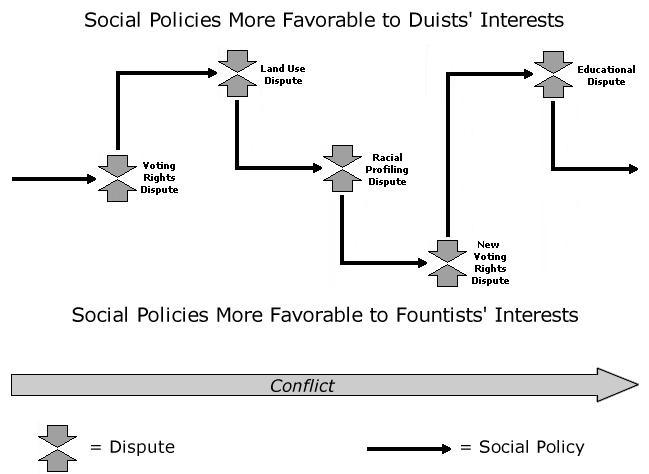 |
International Online Training Program On Intractable Conflict |
Conflict Research Consortium, University of Colorado, USA |
 |
International Online Training Program On Intractable Conflict |
Conflict Research Consortium, University of Colorado, USA |

This figure illustrates the relationship in an imaginary dispute between two ethnic groups in a post-colonial society named Dufountain. The two groups in this hypothetical country are the "Duists" and the "Fountists." Time runs from left to right. Each of the sets of fat arrows represents one short-term conflict, or as the chart calls it, a "dispute." In this illustration, five disputes occur. The first one results in improved policies for the Duists (shown by the solid black arrows going up toward the top of the page). The next two benefit the Fountists. The fourth one benefits the Duists, while the final dispute on this diagram favors the Fountists again. None of the disputes resolves the long-term, underlying conflict; the dispute settlements only alter social policies for a time in a way that favors one group more than another. Whenever the losing group believes that it has gained enough power to prevail in a later dispute, it will most likely try again to engage the opponent and force an outcome that is more favorable to them than the dispute outcome was. For this reason, dispute settlement is not the same thing as conflict resolution. One is a temporary settlement of an immediate problem; the other is a long-term settlement of an underlying long-running conflict.
While this training program is useful for all kinds of conflicts and disputes, it is primarily designed to help people better deal with highly resolution resistant conflicts. Thus, while we will touch lightly on techniques for resolving simpler disputes, our emphasis will be on the management, or what we call "constructive confrontation: of intractable or resolution-resistant conflicts.
For more information on the differences between short term disputes and long term conflicts, see Burton, 1990 and Burton and Dukes, 1990.
Copyright ©1998 Conflict Research Consortium -- Contact: crc@colorado.edu